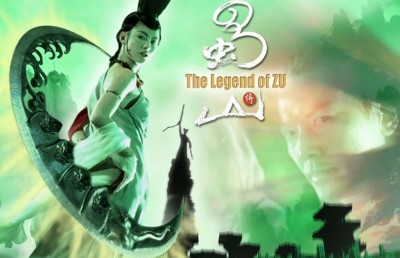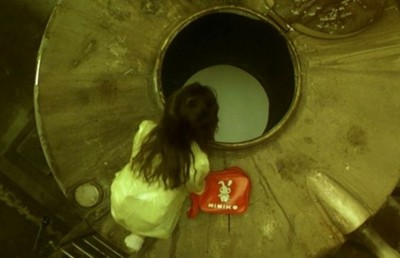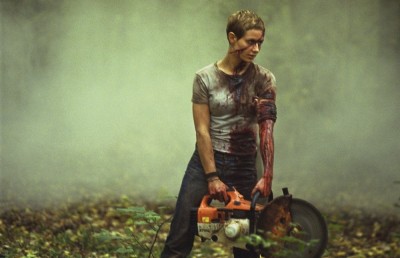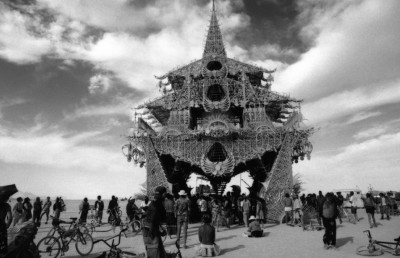One Point 0 Interview
Neo-Noir Science-Fiction
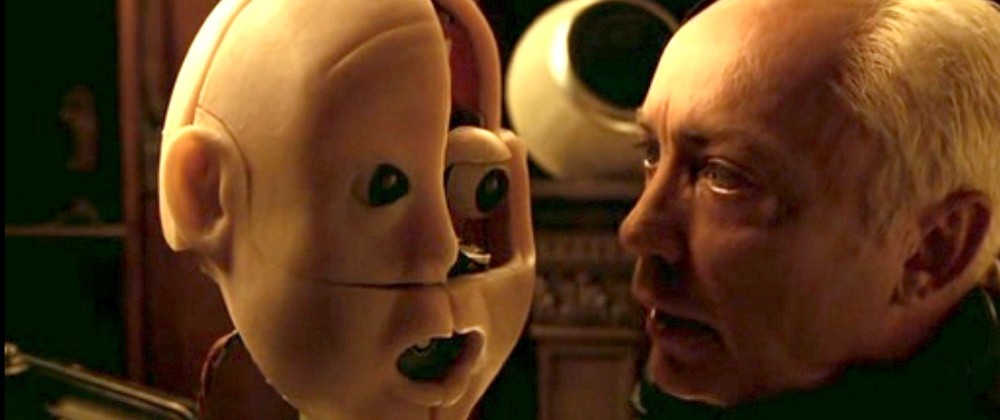
The new, low-budget (1.7 million U.S.) noir science-fiction film One Point 0 had its Canadian premiere at the 2004 Fantasia International Film Festival. The film stars Jeremy Sisto as Simon J, a computer programmer working on an undisclosed project for a large ‘big brother’-like corporation. A majority of the film takes place in and around the dark and dank tenement building where Simon lives and works. The atmospheric building houses most of the film’s other central characters: a sultry nurse (Deborah Unger), an inventor who spends most of his time tinkering with an android head named Adam (Udo Kier), a leather clad man who dabbles in porn gaming (Bruce Payne), and an eccentric janitor who lives in the boiler room and who just may hold the key to the film’s sensual mysteries (an in-form Lance Henriksen). The film’s exercise in aesthetic paranoia is triggered when Simon begins receiving a series of suspicious looking empty packages, with things becoming too close for comfort when one turns up inside his apartment (shades of the mysterious video tape at the beginning of Lost Highway). Simon’s suspicion turns to paranoia and subsequent bizarre behaviour. To make matters worse, he begins to show symptom’s of an illness which caused the spontaneous death of a tenant in the building’s elevator. Meanwhile the building’s entire computer system is suffering from a virus which directly or indirectly seems to be affecting Simon’s physical and emotional well-being. As Simon’s behavior becomes increasingly erratic one begins to wonder: is Simon suffering from a new strain of biomechanical bacteria, or is he loosing touch with reality? Are Simon’s motley band of neighbors part of the problem or solution? Co-director’s Marteinn Thorsson and Jeff Renfroe are less eager to supply quick answers to these enigmas than provide a sumptuous visual and aural atmospheric ‘mindscape’ in which spectators must do their own rational navigating, in the tradition of such films as Mulholland Drive, Eraserhead, Barton Fink, and Chasing Sleep. Even if One Point 0 recalls these earlier works, it manages to carve a niche in this well known dystopian tradition where futuristic consumer technology coexists within a noirish world of stunted emotions and reduced social interaction.
The following interview was conducted with co-directors Marteinn Thorsson and Jeff Renfroe (who joined the interview in-progress) and the second unit director Giovanni Sampogna, in their hotel room on July 14, the day after One Point 0 first screened at the Festival.
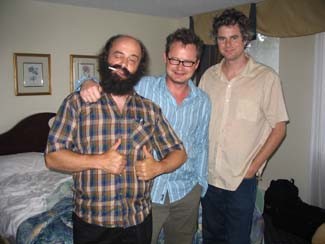
G. Sampogna, M. Thorsson, J. Renfroe
OFFSCREEN: Marteinn, how did you get to this point of making your first feature film?
Marteinn Thorsson: After film school I went to Iceland and did a lot of television work.
OFFSCREEN: Where did you study?
MT: Ryerson in Toronto, which is where I met Jeff Renfroe and Giovanni Sampogna.
Giovanni Sampogna: I worked there as a staff member.
OFFSCREEN: The film has an interesting cast, with Jeremy Sisto, Udo Kier, Lance Henriksen, and Deborah Unger. How did some of the casting come about?
MT: Well we wrote the script with Udo Kier in mind and it just so happened that one of the producers, Thomas Mai, knew Udo from a Danish film he had produced called Besat (1999). Udo agreed actually three years before we made the film. We met in L.A. and gave him the script and he agreed to be in it. Deborah Unger we met at a casting session in Los Angeles and we had also written with her in mind.
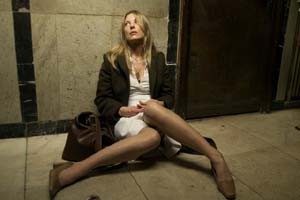
Deborah Unger as Trish
GS: And both her and Jeff are from Victoria B.C.
MT: Well Jeff is from Seattle but he was raised in Victoria.
GS: Jeremy took a long time to cast. At one time we had Adrien Brody right after he won at Cannes in 2002. But our schedules were very tight and we were going to shoot in Winnipeg at that time and it fell through.
OFFSCREEN: Was Udo Kier difficult to work with?
MT: No he was a sweetheart.
GS: A quick little class act story. Udo was there on set for four days. He flies in and we are shooting six days a week, 12 hour shifts. He shows up at 8 in the morning and stays for the whole day. At 8:00 at night we finish the first days shoot and we all sit down at the craft services. A Romanian guy comes up and hands Udo all this cash, “here’s your change sir.” Udo hands him a $20 tip and tells him to bring out the stuff. He brings 4 cases of 24 beer, which the Romanians went through in 10 seconds, 20 bottles of chilled white wine, and two 40 ouncers of vodka and mix and we just sat around talking and listen to Udo tell all these stories about Fassbinder and other directors he worked with. About how he was going to be cast in Fellini’s Satyricon and then Franco Zeffirelli brought in a young boy who Fellini went with instead. And what is left after all this: one bottle of white wine. And then we go to the Grand Marriott and proceed to shut down the bar at 4 in the morning. Udo is a class act. He bought all that stuff with his own money.
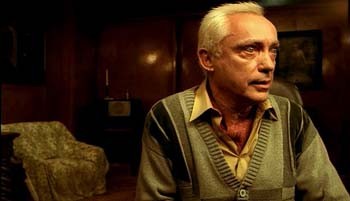
Udo Kier as inventor Derrick
OFFSCREEN: He definitely likes to drink from what I’ve seen the few days here! I’ve heard your film was very well-received in Sundance. Can you give a little summary about how it was received and the feedback at Sundance.
MT: We had five sold-out screenings at Sundance, 3000 people saw it.
OFFSCREEN: What created the buzz?
GS: I was not there – I was in Iceland – but I spoke to them several times while they were there. Early on in the festival Variety did a thing where they named the top 10 new hot directors to watch out for, and guess who was on the list: Jeff and Marteinn. Agents were stalking them. So I think that was part of it and that was early on during the second night. Counting all the festivals they have gone to so far I’d say about 7,000 to 10,000 people have seen the film so far before the actual release.
OFFSCREEN: Plus about 700 here last night. And I’m sure it will sell out tomorrow in the smaller theatre of about 200 seats. What format was a film shot in?
MT: 35mm
OFFSCREEN: Did you like the way the film looked projected last night?
GS: It seemed more like an answer print than a release print. There was no shadow detail which was really weird.
OFFSCREEN: What is the cinematographers Christopher Soos’ background?
GS: He is a fellow classmate of their’s, Class of ’93.
MT: He has done a lot of music video work, big music video stuff like David Bowie, Christina Aguilera, Jimmy Page and Robert Plant, and the Chemical Brothers.
OFFSCREEN: So the crew is from the same generation?
GS: Yes, even the editors Troy Takaki and Daniel Sadler.
MT: And my wife Maria Valles did the costume.
OFFSCREEN: I found that many of the actors, including the minor characters especially, had different accents, some East European some North American. How conscious a decision was that?
MT: I don’t know. I live in Toronto and there are so many different accents in Toronto so it just represents a multicultural city.
OFFSCREEN: Speaking of sound was it all done after the film?
MT: We wrote the sound design into the script. It was very specific. Sound is such an inherent part of film. Film is like music, it has a rhythm, a tempo with cuts and space.
OFFSCREEN: With some films the sound just overwhelms the images. You have to renegotiate that balance. I think you do a good job of that.
GS: The Tavianni brothers wrote a lot of sound into their scripts. I think the sound design in One Point 0 was sort of but not quite like Eraserhead, where the building really comes alive.
OFFSCREEN: Yes, the flickering, cracking lights is right out of David Lynch.
GS: That is where the sound design is a major part of the building’s character, and with the shots down the corridor and a lot of the surveillance shots as well.
OFFSCREEN: There is a film which came to my mind while watching your film and that is Orson Welles’ The Trial (1962).
MT: Oh yes of course, Joseph K.
OFFSCREEN: I find the relationship between Simon and the Deborah Unger character, Trish, a lot like the relationship between the Anthony Perkins and the Jeanne Moreau character. The way Perkins acts so reticently and the way the cops appear at his front door. Even the way you use spaces reminded me of The Trial they way you go from one location to the next with very stark contrasts in the locations. (At this point co-director Jeff Renfroe enters the room and joins into interview). I think it also helps the theme of paranoia to have all these completely different spaces, Simon J’s apartment, the grocery store, the corridors. You move into a space which is supposed to be a normal environment and the sense of paranoia is actually increased.
GS: I define paranoia as a heightened sense of awareness and if you define it that way I think it leads to a wholly different scenario. Paranoia is the glue that is holding Bush’s administration together. With all those color-coded ‘terror’ ratings that go red, blue, yellow. Michael Moore deals with it in Bowling for Columbine and in Fahrenheit 9/11. That is a sign of the times.
OFFSCREEN: How do you work as co-directors?
GS: Just a little story about the way the shooting went with Jeff and Martin and the cinematographer. Jeff and Martin worked on all lot of films together at school so they have been in rhythm since about 1989. A quick story to sum up overall how the film was shot. The film was shot in 30 days, five days, six weeks, and 12 hour days. They presented a shot list of 750 shots to the first AD (assistant director) Chris Landry. I turned to them and said you guys are slowing down only 750 shots! Chris Landry is a Hollywood guy, this was about his 19th feature, his first in Romania. His wife is Romanian. He read us the riot act and said, “well you know boys, that is very ambitious but if you really want to impress me cut down about 20% and if he can get about 600 shots you’ll impress the shit out of me.” I turn to them after the meeting, because I know Jeff and Marteinn’s style, and said before you ever think of throwing away a shot just give it the second unit. And if we don’t get it, well we don’t get it. Well for what it is worth we were half a day ahead of schedule. We finished in 29 and one half days. And on the slate number, which is a total of all the shots you have done, including the second unit stuff, was slate No. 1000. Of course Chris was floored. In interviewing him for the “making of” documentary film he said that he had never seen young directors and a young DP work so close together. But I knew because they had worked together from school onwards for 15 years.
OFFSCREEN: So the second unit stuff was filmed during the same block of days.
Jeff Renfroe: Yes. A lot of these inserts and macro stuff were done by the second unit. We would move to another set and second unit would come in and pick up whatever we had missed.
GS: Just to finish on how they worked together. You figure with two co-directors you can get twice as much work done but they were always on set together. The way they would work is that one was on the set with the actors and the other at the monitor and then they would switch it up.
JR: And sometimes I would break away and go with second unit when the there were key shots to be done, like the outside of the apartment building. During the final days when we were trying to wrap out of that building we would break off because we knew that would be the last time we would be in that building.
OFFSCREEN: With regards those shots outside Simon’s apartment building, I found the way you composed those shots of Simon walking down the outside steps reminded me again of The Trial and the shots of characters walking down the steps of the Orly train station.
GS: Another key person on the second unit was Andy Hallbach, who was Chris’ main assistant. He calls him his Renaissance man.
JR: He is usually Chris’ first assistant in L.A. but we brought him in basically to DP the second unit.
OFFSCREEN: For the camera movements did you lay down tracks or was it dolly work?
JR: We used tracks for everything except the hallway because the floors were bad.
OFFSCREEN: Getting back to the content of the film. It is a convention of cyberpunk to mix old technology with new technology, which you also do. Why do you think that convention persists?
JR: I think that it is just more realistic. I look at the computer system I have at home and even though I have an Apple G 3 PowerBook I still have cords running all over the place to this box I bought five years ago. So you are always patching things together because when you cannot afford the new technology you go back to use old parts.
MT: You can still buy vinyl.
GS: And Commodore 64’s!
OFFSCREEN: I think the central idea of the film is quite frightening, this symbiotic link between technology and the human world where disease can go from technology to a human. That is scary but it may be even more frightening if it goes the other way around, with human disease going into technology. Which perhaps is another film.
JR: Adam gets cancer of the brain!
GS: In the same vein if I was to sum up One Point 0 it is the future biology of advertising. It is like subliminal seduction redefined. Nanomytes implanted in your brain so you just want to buy those products.
OFFSCREEN: Just a comment. There’s actually a short film called The Bronswick Affair from 1978 by the NFB directed by Robert Awad which treats the identical theme. The Bronswick is the brand name of a television which emits a signal that makes people go out and buy things they don’t need. So you have this shot of man standing at a bus stop with a six-foot high stack of car tires. Which is also similar to Larry Cohen’s The Stuff (1985). Your film adds something of course with the computer technology and the stronger psychological element. I think there are two ways of looking at your film. It could be a physical virus that is spreading, but it could also be a psychological dependence, the idea that, psychologically, technology has taken over us. Whether it is a physical or psychological problem it ends up being the same.
OFFSCREEN: The Lance Henricksen character, Howard, is quite an interesting character. You can interpret him as being a good character or a bad character. Is he saving the brains or is he selling the brains? If indeed the brains are being reused, in what way do think the ‘stolen’ brains would be used by the corporation?
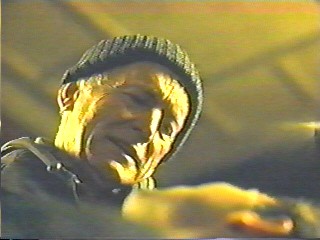
Lance Henricksen as Howard
JR: I think Howard right now is just thinking as an archivist. The technology maybe isn’t quite there to do anything with these brains at the present moment, but in his delusion he thinks that one day there will be a way to bring them back to life.
OFFSCREEN: Like cryogenics a bit. I was also thinking of Howard’s robotic crickets and how they could also be a source of the virus.
GS: That is how Howard knew when to come; the crickets called him.
JR: They are just an earlier invention of Howard’s which gives us a hint that he has this background in nanomytes.
MT: In fact Howard is loosely based on a real life person who I did a documentary on for television, a guy who just dropped out of society. He was a very successful computer wizard who ran IBM in Iceland. He had a house, family, children, wealth, everything, and then one day he just sold everything he had, gave the money to his family and left society. He bikes around Iceland for about 8 or 9 months of the year and camps in a tent. He writes music and theories of life and existence. He actually co-wrote Bjork’s first songs when she was 12 years old in Iceland. His name was Björgvin Holm. He was also an Olympic athlete and was at the Olympics in Rome. At one point he just said goodbye to it all. He was the inspiration for Howard character.
JR: What would happen if Bill Gates came to senses? It would make him completely insane because of what he has done, so he goes underground and tries to fight the monster he has created.
OFFSCREEN: As I mentioned in my catalog notes on the film, the Howard character also reminded me of the Roberto De Niro character in Brazil (1985), the renegade plumber. How close is this nanomyte technology to reality?
JR: They are just playing around with it right now. The first use of it is in medicine. For example, they know the cold virus goes to certain places in the body, so they will hack off the motor to that virus and attach their bit of medicine and one piece of nanodye color so they can track it through the body.
GS: It is a delivery system to a specific part in the body right now.
JR: The actual term “nanomyte” was something we created for the film.
MT: In the cosmetic industry it is being used too for pigmentation and creams.
JR: And they are advertising these fabrics that are nano-fabrics, like Udo’s couch in the film, that is supposed to repel stains.
OFFSCREEN: Like in the Alec Guinness film Man in the White Suit (1951).
OFFSCREEN: Sometimes a particular line will stick out in a film and the line I liked a lot in the film was, “there are changes happening.” It is a very evocative line. Was that written on the spur of the moment or did you really play around with that term.
MT: Well yes, the latter, because Adam the robot head says it originally and he does not really know the language.
JR: He is trying to warn people of this horrible virus coming and that is just one of the key phrases he thinks people will pick up on. So in his barrage of trying to get through to Simon J. he sends these messages out. We don’t really see this because it is part of the back-story, but he sends them to his neighbors too. Which is why you see the neighbors starting to pick up on this saying, “there are changes happening.”
OFFSCREEN: Who designed the robotic head?
JR: Carlyle Livingston was the main designer. And Pat Denver was also involved.
OFFSCREEN: Was it fully operational?
JR: Yes, we were able to operate it which was great because we knew what kind of reactions we wanted. So they just handed us this thing which you can operate like a remote control car.
OFFSCREEN: Was it modeled after any face in particular?
MT: It was modelled to look like a newborn child or a child of two or three months that we saw on the internet. It was deformed and had this weird quality to it.
JR: But it was completely sad and pathetic, so you want to give it a hug and some milk. We wanted it to have this quality were it was a little scary but also pleading for you to help it.
GS: One last thing with the term “there are changes happening.” It reminds me of this quote from George Orwell, and I paraphrase: “to see what is in front of one’s nose needs a constant struggle.”
OFFSCREEN: If you had to make a sequel, and this film could theoretically have a sequel, what direction would you see it taking?
MT: It would be about Simon’s daughter, because Trish is pregnant at the end, and Howard. And Adam/Simon.
JR: We always kind of thought of One Point 0, Two point 0, Three Point 0. We wanted to do a trilogy, where each one would become more complex and the world in them would grow, with the last one dealing with how the virus has affected the whole world.
OFFSCREEN: Is there any possibility of that happening?
JR: Sure! (laughter all around)
OFFSCREEN: Is a DVD releases imminent?
GS: January. With a commentary track and a making of film which I directed called 1.5, about 12 minutes long.
OFFSCREEN: Your recent project is called Stray Toaster. Can you talk about that a bit.
JR: Stray Toaster is a graphic novel, a comic book by Bill Sienkiewicz. It came out in the 1980’s. He came up with people like Frank Miller and he illustrated a lot for those guys. This is the one thing that he wrote and illustrated. It is in four parts, and we are adapting it now. It is very much in the same vein as One Point 0. It is a bigger, more complex world and is another science-fiction/film noir with robots and technology run amok.
GS: Jeff and Marteinn have been writing like mad the past two weeks and are about 95% done writing the first draft of the script.
OFFSCREEN: Do you have any funding for it yet?
JR: No. We have the book, almost the script, and we do have a relationship with this effects house called “The Orphanage.” They broke off from Industrial Light and Magic and have a well-established name. They did a lot of work on Hell Boy and the Matrix movies. Now they want to start developing their own projects as producers. We are working with a woman there named Amy. She looked at the book and said their artists would love to do something like this because it is not your run-of-the-mill science-fiction. It has a guy with a toaster on his head, and amalgamates all these home appliances. It has a quirky, strange vision to it.
OFFSCREEN: Well good luck with that and thanks for your time.
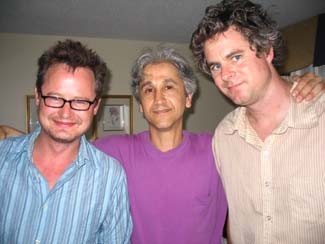
M. Thorsson, D. Totaro, J. Renfroe
Official One Point 0 site (make sure you have antivirus software installed before you venture….)



